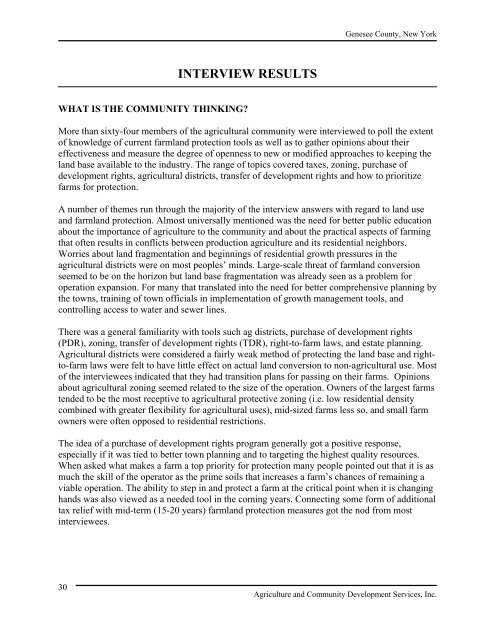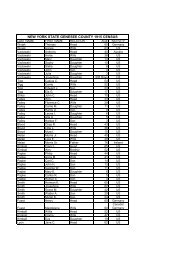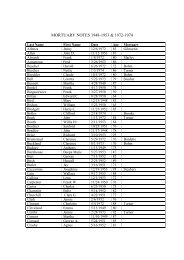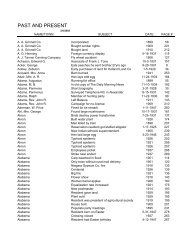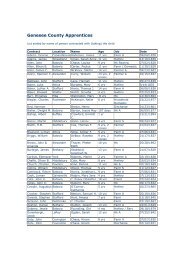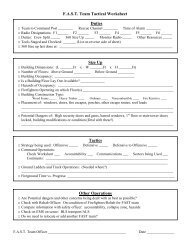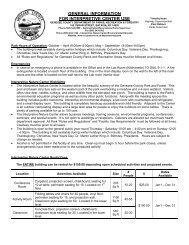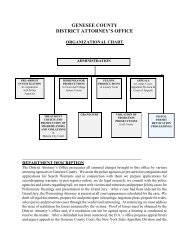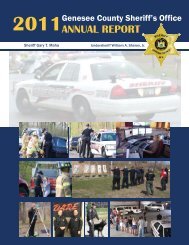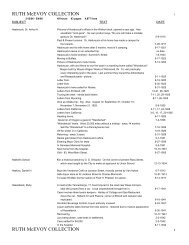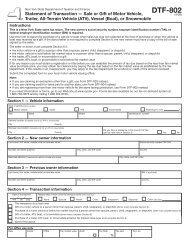Genesee County Agricultural and Farmland Protection Plan
Genesee County Agricultural and Farmland Protection Plan
Genesee County Agricultural and Farmland Protection Plan
You also want an ePaper? Increase the reach of your titles
YUMPU automatically turns print PDFs into web optimized ePapers that Google loves.
<strong>Genesee</strong> <strong>County</strong>, New York<br />
INTERVIEW RESULTS<br />
WHAT IS THE COMMUNITY THINKING?<br />
More than sixty-four members of the agricultural community were interviewed to poll the extent<br />
of knowledge of current farml<strong>and</strong> protection tools as well as to gather opinions about their<br />
effectiveness <strong>and</strong> measure the degree of openness to new or modified approaches to keeping the<br />
l<strong>and</strong> base available to the industry. The range of topics covered taxes, zoning, purchase of<br />
development rights, agricultural districts, transfer of development rights <strong>and</strong> how to prioritize<br />
farms for protection.<br />
A number of themes run through the majority of the interview answers with regard to l<strong>and</strong> use<br />
<strong>and</strong> farml<strong>and</strong> protection. Almost universally mentioned was the need for better public education<br />
about the importance of agriculture to the community <strong>and</strong> about the practical aspects of farming<br />
that often results in conflicts between production agriculture <strong>and</strong> its residential neighbors.<br />
Worries about l<strong>and</strong> fragmentation <strong>and</strong> beginnings of residential growth pressures in the<br />
agricultural districts were on most peoples’ minds. Large-scale threat of farml<strong>and</strong> conversion<br />
seemed to be on the horizon but l<strong>and</strong> base fragmentation was already seen as a problem for<br />
operation expansion. For many that translated into the need for better comprehensive planning by<br />
the towns, training of town officials in implementation of growth management tools, <strong>and</strong><br />
controlling access to water <strong>and</strong> sewer lines.<br />
There was a general familiarity with tools such ag districts, purchase of development rights<br />
(PDR), zoning, transfer of development rights (TDR), right-to-farm laws, <strong>and</strong> estate planning.<br />
<strong>Agricultural</strong> districts were considered a fairly weak method of protecting the l<strong>and</strong> base <strong>and</strong> rightto-farm<br />
laws were felt to have little effect on actual l<strong>and</strong> conversion to non-agricultural use. Most<br />
of the interviewees indicated that they had transition plans for passing on their farms. Opinions<br />
about agricultural zoning seemed related to the size of the operation. Owners of the largest farms<br />
tended to be the most receptive to agricultural protective zoning (i.e. low residential density<br />
combined with greater flexibility for agricultural uses), mid-sized farms less so, <strong>and</strong> small farm<br />
owners were often opposed to residential restrictions.<br />
The idea of a purchase of development rights program generally got a positive response,<br />
especially if it was tied to better town planning <strong>and</strong> to targeting the highest quality resources.<br />
When asked what makes a farm a top priority for protection many people pointed out that it is as<br />
much the skill of the operator as the prime soils that increases a farm’s chances of remaining a<br />
viable operation. The ability to step in <strong>and</strong> protect a farm at the critical point when it is changing<br />
h<strong>and</strong>s was also viewed as a needed tool in the coming years. Connecting some form of additional<br />
tax relief with mid-term (15-20 years) farml<strong>and</strong> protection measures got the nod from most<br />
interviewees.<br />
30<br />
Agriculture <strong>and</strong> Community Development Services, Inc.


